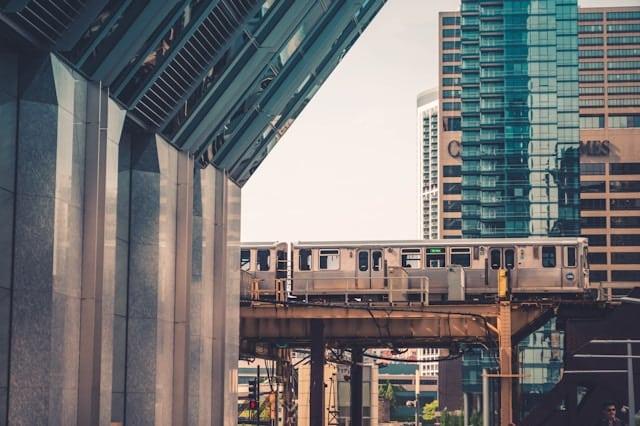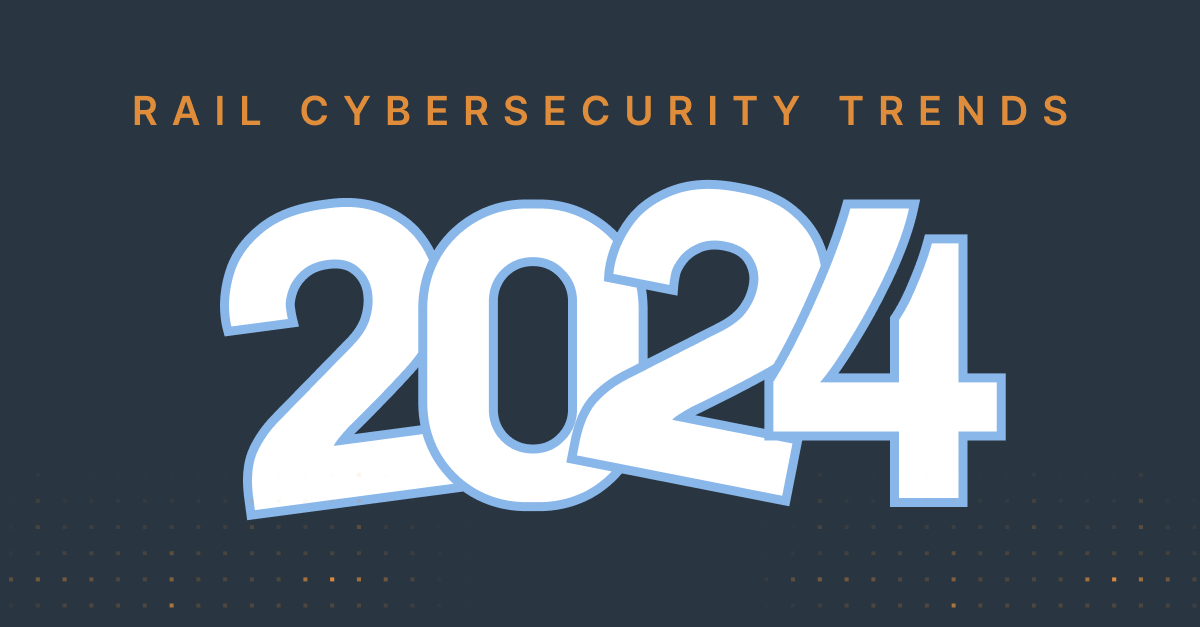The global rail sector is undergoing a major digital transformation with changes that are, both, accelerating the popularity of the industry, securing it as a major player in a world of rapid commerce, growing innovation, and increasing sustainability goals, and making it a major target for cyberattacks. Cyber awareness in this category is very recent but is forcibly growing at a rapid pace. Transportation systems, especially railways, are considered critical infrastructure, and a threat to a rail system is a threat to national security.
In 2023, we saw various instances of how quickly a cyber attack can paralyze a nation’s public transportation systems, such as the attack on Poland’s railway network, and cause significant financial and reputational damage. It was also the year of rail cybersecurity compliance with the release of NIS2 and the renewal of the TSA Security Directives for rail, and a more dedicated and sophisticated application of AI throughout the tech space. Cervello was ahead of the curve in this category, releasing the first ever rail cybersecurity compliance dashboard, Cervello Compliance. It has been an exciting year, to say the least; so, what awaits us in 2024?
Cervello’s 2024 Rail Cybersecurity Trends Forecast
Former FBI Director, Robert Mueller, once said, “there are only two types of companies: those that have been hacked, and those that will be.” Read below what we believe will be 2024’s eight leading rail cybersecurity trends:
- Increased Focus on Cyber-Resilience: In 2024, there will be a heightened focus on building cyber-resilient systems. The concepts of cybersecurity and cyber resilience, while closely related, serve distinct purposes and their differentiation is expected to gain prominence.
Cybersecurity primarily refers to the prevention of cyber attacks, implementing measures to protect systems and data from unauthorized access or harm. On the other hand, cyber resilience acknowledges that no system can be entirely impervious to attacks and it is therefore critical for operational continuity that measures are in place to quickly detect and act on incidents when they do occur. This year, the strategic focus of many organizations is predicted to shift towards enhancing their cyber resilience. This entails applying technologies that support cyber threat mitigation and rapid remediation, ensuring that the core functions of the organization can continue even in the face of security challenges. - Proactive Security Tools and Technology: Organizations are likely to invest more in proactive security tools to better detect vulnerabilities and security gaps. With the increasing sophistication of cyber threats and the real potential consequences of a rail cyber attack, reactive security measures are no longer sufficient to protect against today’s evolving risks.Technologies such as risk-based vulnerability management, asset and misconfiguration management, and security posture tools will become more prominent.
In 2024, the focus will be on not just defending against threats, but also anticipating them. By investing in proactive security tools and technologies, organizations aim to stay one step ahead of cybercriminals, minimizing their risk and enhancing their overall security posture.
- Rail-Specific Cybersecurity Strategies: The rail sector is expected to continue implementing encryption, secure authentication protocols, and continuous monitoring to guard against cyber threats. The sector is also likely to face challenges related to the integration of modern technologies with legacy systems, necessitating a technology that can recognize and secure proprietary, industry-specific systems and software and address supply chain risks. Strategies will need to encompass not just the internal systems but also the external networks and components that form part of the rail infrastructure.
Overall, the industry’s strategy in 2024 will likely be characterized by a proactive and adaptable approach that is rail-specific. The complexity of rail network architecture is such that without the proper cybersecurity solutions in place that can identify proprietary protocols, policies, and systems, rail operations remain at high risk. Rail organizations need cybersecurity solutions specifically tailored to their protocols, technologies, methodologies, and systems in order to ensure safe and reliable transport.
- Emphasis on Operational Technology (OT) Security: U.S. rail owners and operators are expected to intensify efforts in identifying critical cyber systems. The trend towards enhanced OT security in the rail industry in 2024 will involve a comprehensive approach that includes the identification of critical assets, network segmentation, advanced control measures, continuous monitoring, and the adoption of new technologies, all within a framework of collaboration and regulatory compliance. These efforts aim to fortify the rail sector against the increasing threats in the cyber landscape.
Rail operators will focus on accurately identifying and cataloging critical cyber systems that are essential for safe and efficient rail operations, using cybersecurity techniques such as network segmentation, to limit the potential damage from cyberattacks and reduce the risk of widespread system failures. In 2024, rail operators will keep a much closer look at all operational systems to quickly identify any signs of malicious activity or system anomalies. The integration of advanced technologies like Artificial Intelligence (AI) and Machine Learning (ML) for anomaly detection and predictive analytics in OT security will greatly support this.
- AI and Machine Learning for Threat Detection and Response: AI and ML are expected to play a larger role in cybersecurity. Their ability to analyze vast quantities of data rapidly allows for quicker and more accurate identification of potential threats, including unusual patterns and anomalies that might not be easily detected by human observation. Moreover, these technologies are adept at behavioral analysis, a critical factor in identifying insider threats. This is increasingly important in the rail industry, where security breaches can have severe implications for public safety and infrastructure integrity.
As the cyber threat landscape continues to evolve, the adaptability of AI and ML to learn from new types of attacks and adjust detection mechanisms accordingly will be a key asset. The trend in 2024, therefore, points towards leveraging AI and ML not just as tools for enhancing existing cybersecurity measures in the rail industry, but as fundamental components of a more resilient, responsive, and adaptive security strategy.
- Increased Focus on Identity Verification: In 2024, we can expect a broader adoption of identity verification technologies. The advancement of AI technology has enabled rail operators to refine and enhance their identity verification protocols, making them not only more secure but also more efficient and user-friendly. This is critical in staying one step ahead of cyber threats.
As the rail industry becomes increasingly interconnected and reliant on digital systems, it becomes a prime target for malicious actors seeking to disrupt operations, steal sensitive data, or even compromise safety. In this landscape, robust identity verification becomes a crucial defense mechanism. - Collaboration and Information Sharing: With a greater focus on compliance, there will be an increased emphasis on collaboration and information sharing within the industry and with government agencies. One key driver behind this trend is the growing recognition that the threat landscape is continually evolving, so when rail operators and industry players pool their knowledge and resources, they are better equipped to detect and respond to emerging cyber risks.
Moreover, collaboration extends beyond the boundaries of the rail industry itself. Government agencies have a vested interest in ensuring the security and reliability of critical infrastructure, including railways. Recognizing the interconnected nature of modern rail systems and the evolving cyber threat landscape, rail operators, manufacturers, and government agencies have come together to enhance their collective security posture. This collaborative approach enables rapid threat detection, proactive risk mitigation, and the cultivation of a cybersecurity culture that is steadfast in its commitment to safeguarding the integrity and reliability of rail transportation.
- Unified Cybersecurity Standards and Compliance: Regulation authorities around the world are continuously drafting, discussing, and reviewing cybersecurity standards for critical infrastructure, particularly railways, which until the past few years had been paid very little attention to. While Europe has tried to implement rail cybersecurity compliance for years, the amount of legacy infrastructure has kept it from turning mere suggestions to requirements and thus stalled the process of full compliance. The US’ TSA has paved the way in making rail cybersecurity compliance non negotiable and has inspired many other governments to follow suit. The European Rail Supply Industry is now recommending the sole implementation of TS 50701 in the railway sector to avoid fragmentation of cybersecurity criteria. Collaboration between stakeholders is essential for addressing emerging cybersecurity challenges and we will likely see more of this throughout this year.
In conclusion, 2023 marked a pivotal year for rail and transportation cybersecurity, with increased attention to compliance, threat detection, and visibility. As we venture into 2024, the industry is poised to continue its evolution, embracing new strategies and technologies to protect against the ever-present and ever-evolving cyber threats. By staying vigilant and adaptive, the rail and transportation sector can navigate this digital era with confidence and security.


